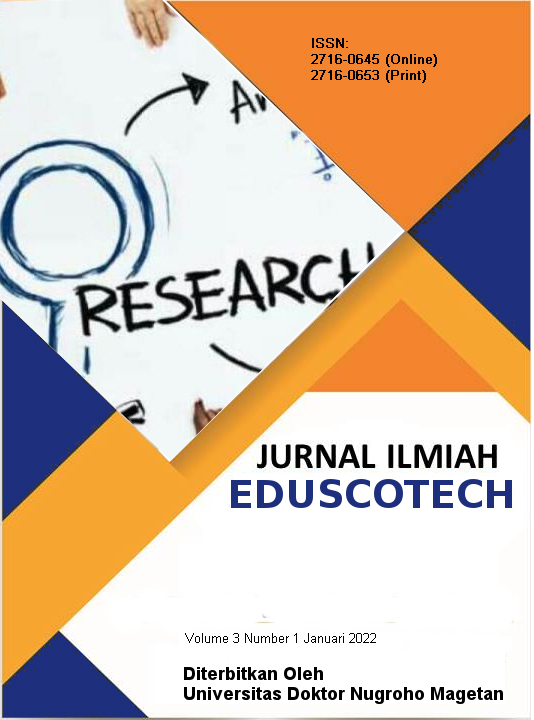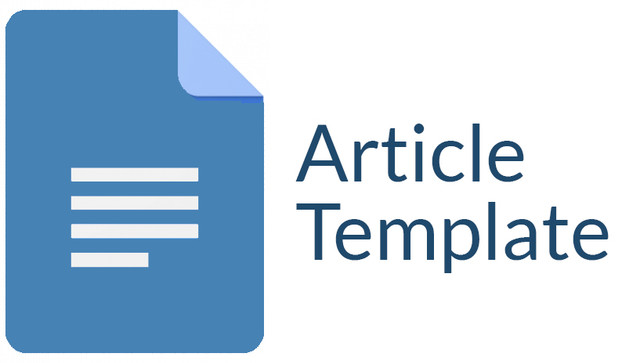Penggunaan Media Gambar Dalam Meningkatan Hasil Belajar Matematika Siswa Kelas III SDN Ngujung 2
Keywords:
Image Media, Mathematics Learning Results, SDN Ngujung 2Abstract
This research is motivated by the learning outcomes of students who are not good enough in Mathematics class II SDN Ngujung 2. This is because students consider mathematics a difficult subject, and in the mathematics learning process, media has not been used to convey messages to students so as to encourage the learning process. On the other hand, there is a tendency that students are less enthusiastic when participating in the learning process so that students do not understand the material which results in low learning outcomes. The purpose of this study was to determine the improvement in learning outcomes through image media in Mathematics class II SDN 2 Ngujung, Maospati District, 2021/2022 Academic Year. On the material of flat shapes. This type of research uses Classroom Action Research (CAR). This research was conducted for 2 cycles, each cycle had 2 meetings. The subjects were 10 students. Data collection techniques in this study were in the form of observation sheets, tests and documentation and analysis techniques using quantitative and qualitative analysis. The results of this study showed that the learning outcomes of students in cycle I were 60% then increased by 30% because in cycle II it increased to 90%. Based on the results of the study, it can be concluded that the use of media can improve student learning outcomes in Mathematics subjects for class II SDN Ngujung 2 in the 2021/2022 Academic Year.
Downloads
References
Agus Suprijono, Cooperative Learning Teori dan Aplikasi Paikem, Yogyakarta: Pustaka Belajar, 2015
Anas Sudjiono, Statistik Pendidikan, Jakarta: Raja Grafindo Persada, 2003
Azhar Arsyad, Media Pembelajaran, Jakarta:PT Raja Grafindo, Cet: 19, 2016
Basyiruddin Usman dan Asnawir, Media Pembelajaran, Jakarta: Ciputat Pers, 2002
Gatot Muhsetyo,Dkk, Pembelajaran Matematika SD,Jakarta: Universitas Terbuka,2009
H. Hamzah B. Uno, Profesi Kependidikan, Jakarta: Bumi Aksara, cet: 11, 2016
Kurikulum Tingkat Satuan Pendidikan (KTSP), Depdiknas,2006
Kunandar, Langkah Mudah Penelitian Tindakan Kelas Sebagai Pengembangan Profesi Guru, (Jakarta:PT Raja Grafindo Persada, 2013
M. Iqbal Hasan, Pokok-Pokok Materi Statistik 1, Jakarta: Bumi Aksara, 2003
Muhammad Thobrani & Arif Mustofa, Belajar & Pembelajran, Yogyakarta: Ar-Ruzz Media, 2013
Muhibbin Syah, Psikologi Pendidikan, Bandung: PT Remaja Rosdakarya Offset, 2014 Edisi Revisi
Purwaningsih, L., Hadianti, A., & Marsini, M. (2022). PROTOTYPE DESIGN FLIPBOOK MEDIA IN TEACHING GRAMMAR “SIMPLE PAST TENSE”. Indonesian EFL Journal, 8(2), 287-294.
Nana Sudjana dan Ahmad Rivai, Media Pembelajaran,Bandung: Sinar Baru Bandung, 1990
Nana Sudjana, Penilaian Hasil Proses Belajar Mengajar, Bandung: PT Remaja Rosdakarya,2009
Oemar Hamalik, Proses Belajar Mengajar, Jakarta:PT Bumi Aksara, 2001
Saiful Bahri Djamarah dan Aswan Zain, Strategi Belajar Mengajar, Jakarta: Rineka Cipta, 2006
Sugiono, Metode Penelitian Pendidikan, Bandung: lfabeta, 2013.
Downloads
Published
Issue
Section
License

This work is licensed under a Creative Commons Attribution-ShareAlike 4.0 International License.
Authors who publish with this journal agree to the following terms:
1. Copyright on any article is retained by the author(s).
2. The author grants the journal, right of first publication with the work simultaneously licensed under a Creative Commons Attribution License that allows others to share the work with an acknowledgment of the work’s authorship and initial publication in this journal.
3. Authors are able to enter into separate, additional contractual arrangements for the non-exclusive distribution of the journal’s published version of the work (e.g., post it to an institutional repository or publish it in a book), with an acknowledgment of its initial publication in this journal.
4. Authors are permitted and encouraged to post their work online (e.g., in institutional repositories or on their website) prior to and during the submission process, as it can lead to productive exchanges, as well as earlier and greater citation of published work.
5. The article and any associated published material is distributed under the Creative Commons Attribution-ShareAlike 4.0 International License









